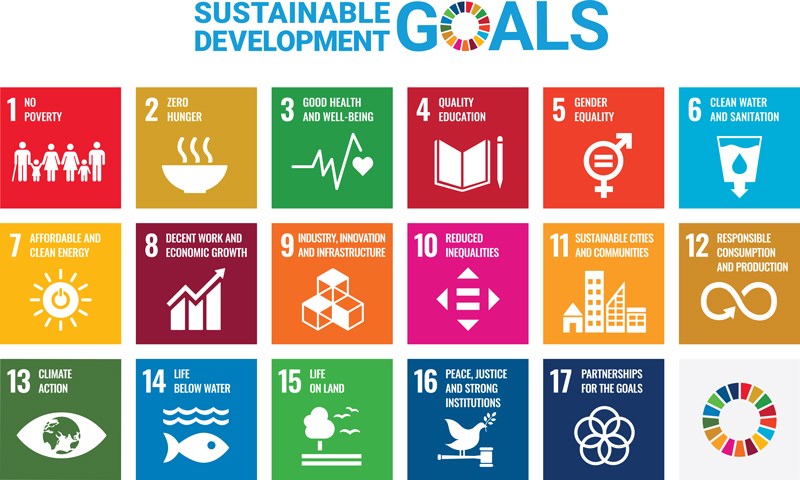Planetary health needs to be addressed at a societal level for any meaningful impact to occur. As the global director of sustainability for a law firm, Marion Palmer provides an overview of the responsibilities of corporate organisations for both a vision of and a commitment to sustainability.

© United Nations www.un.org/sustainabledevelopment
Sustainability is thought to have derived from French and German words which loosely translate to ‘lastingness’. In recent years, this word has become associated with tackling the environmental concerns relating to the non-clinical side of medicine, with examples including implementing energy efficiency features in MRI [1], minimising the amount of waste that is generated, and the production of consumables used in ENT.
United Nations
In 1987, the United Nations Brundtland Commission defined sustainability as “meeting the needs of the present without compromising the ability of future generations to meet their own needs” and in 2012, the UN created the 17 UN Sustainable Development Goals. These goals have prompted a raft of environmental, social, governance and sustainable development goal aspirations. With the increasing awareness of climate change, the destruction of nature, and the need to better use the resources of the planet, organisations have made commitments to improve their sustainability, from becoming carbon neutral to setting net zero goals.
The need to implement sustainable activity and transition to a low-carbon economy is more pressing than ever, but the sustainability landscape is not a simple one to negotiate. In particular, the terminology is in constant flux and there is an ever-increasing emphasis on ensuring that sustainability statements are accurate and supported.
Many organisations whose visions were aligned to the sustainable development goals adopted early commitments related to sustainability, which used terminology that was, at the time, ill-defined. Recent guidance from organisations such as the Science Based Target initiative (SBTi), the World Resources Institute and the International Organization for Standardization (ISO) has set guidance which specifies the minimum standard required to meet commitments, such as the Corporate Net Zero Standard (https://sciencebasedtargets.org/net-zero). With these definitions in place, organisations may have to re-examine or re-state their previous commitments.
Definitions of commonly used terms are also being provided by recent and upcoming legislation. The EU’s Corporate Sustainability Reporting Directive (CSRD) will come into play for many companies over the next few years and is designed to assist companies “to disclose information on what they see as the risks and opportunities arising from social and environmental issues, and on the impact of their activities on people and the environment.” [2].
EU-related guidance on corporate sustainability reporting defines ‘sustainability matters’ as “environmental, social and human rights, and governance factors” [3] and ‘sustainability factors’ as additionally including “employee matters, respect for human rights, anti‐corruption and anti‐bribery matters” [4]. With this wide range of areas to cover, the assessment of adverse impacts, and implementation of changes to improve sustainability could potentially be overwhelming for medical institutions, companies and individuals.
To address this problem, many organisations are working to prioritise elements which will have the greatest impact in terms of sustainability. A materiality, or double materiality exercise aims to narrow the scope of issues by assessing both the impact that an organisation can have on specific sustainability topics and the impact (usually financial) on the organisation itself as a consequence of disruption to sustainability. In this way it is possible to identify and prioritise issues which should be addressed by the organisation, both to improve global sustainability and also to best position the organisation for success. A simple example would be an organisation that inefficiently uses large quantities of water in the creation of its product (overconsumption – impact out) and is also dependent on plentiful local water to maintain its business (undersupply risk – impact in). Prioritising water efficiency as a sustainability measure would greatly benefit the local environment and society, in addition to reducing the risk of water shortages adversely affecting the company’s business. Once impacts are determined and commitments established, the next steps involve quantifying a baseline and measuring progress against commitments.
For individuals who wish to do so, there are innumerable apps and carbon calculators to help assess environmental impact, and to track efforts to reduce emissions and lead more sustainable lives but, at an organisational level, this becomes significantly more difficult. Steering sustainability in an organisation requires facilitating those with knowledge and experience to work in a more sustainable way, whether they be in finance, construction or people management. Moving towards better sustainability requires understanding an organisations’ impacts and commitments, as well as understanding the role individuals play in delivering the solutions, providing a network of support, and a clear credible plan for delivery.
The content of this publication has not been approved by the United Nations and does not reflect the views of the United Nations or its officials or Member States.
References
1. Siemens Healthineers. Sustainability in MRI: The power of less is more.
www.siemens-healthineers.com/en-uk/
magnetic-resonance-imaging/sustainability-in-mri
2. European Commission. Corporate sustainability reporting.
https://finance.ec.europa.eu/capital-markets
-union-and-financial-markets/company-reporting
-and-auditing/company-reporting/
corporate-sustainability-reporting_en
3. European Commission. Annex II. 2023.
https://ec.europa.eu/finance/docs/
level-2-measures/csrd-delegated-act
-2023-5303-annex-2_en.pdf
4. Regulation (EU) 2019/2088 on sustainability‐related disclosures in the financial services sector.
All links last accessed October 2023.









